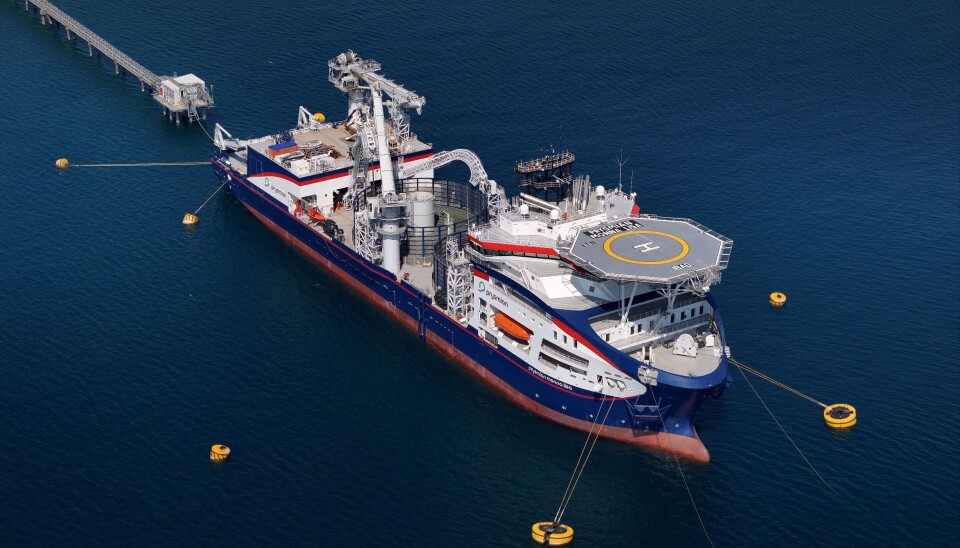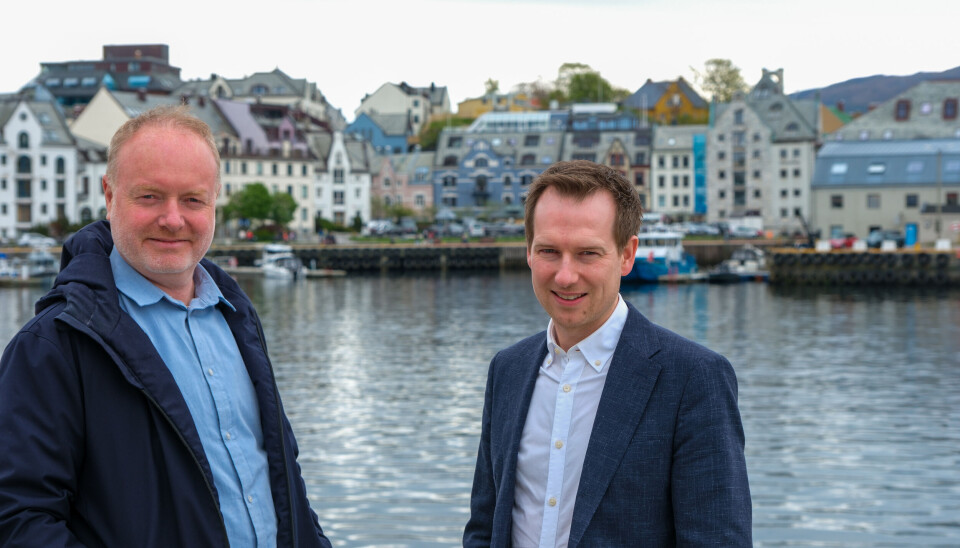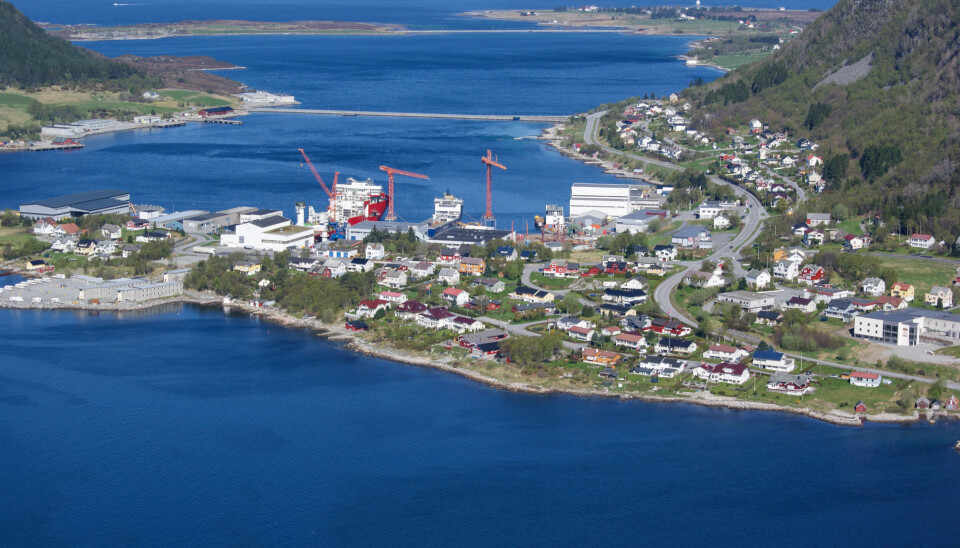
Built in Record Time
Constructing a vessel of this size within a standard timeframe is challenging enough. But when six weeks are shaved off the schedule, one might expect it to be too much to handle. That was not the case.
When the contract between Prysmian and VARD was signed, a project kick-off was held. The company’s Chief Operating Officer, Erik Hellan Sandnes, pointed to the delivery date and said:
“If we manage this, it’ll be a world record.”
Whether the construction of Prysmian Monna Lisa actually set a world record for build time is unclear. But someone took note of the comment, says Project Manager Per Gunnar Søvik.
“He was going to be reminded of that,” he says with a big smile.
The challenge of building the vessel was one thing. Getting the equipment delivered on time was another – especially given the current geopolitical climate.
“In Romania, we kept up a good pace, but to manage a hull of this scale, we had to extend by six weeks. That affected completion at VARD Søviknes,” says Søvik, gesturing toward Shipyard Director Arnt Inge Gjerde.
An already extremely short construction schedule was thus cut by six weeks. And as if that weren’t enough: when the hull arrived, it was time for summer holidays at the yard.
“Many changed their holiday plans, and we kept each other motivated to make it happen,” says Gjerde.
Never afraid of a challenge
Søvik and Gjerde highlight the strong workplace culture at the yard – a culture of stepping up for each other and for the project’s success. Cooperation with the union representatives was also excellent.
“When the workforce sees the yard as ‘ours’, and we work for each other, that’s incredibly valuable. It might sound like a cliché, but that’s truly how it is at VARD Søviknes,” says Søvik, who has spent many years at the yard.

“It creates a strong team spirit,” agrees Gjerde. “The team at Søviknes is never afraid of a challenge. It’s quite unique to find the motivation for such a tough run like the one we had last autumn.”
Most projects have a built-in buffer. This one had none.
Gjerde notes that because VARD controls both hull construction and outfitting, it allows them to adjust the strategy along the way and influence the pace in ways that wouldn’t be possible if the hull were built externally.
“When we start a project, we establish a build strategy. It’s like a train leaving the station – equipment has to arrive in the right sequence. But when advanced systems are delayed, it’s crucial to pivot quickly and with a solution-oriented mindset,” says Gjerde.
Søvik served as project manager at group level, coordinating across project leads and developing methodology together with them.
“The outfitting yard is involved already in the early stages of hull construction. In this project, we were lucky to have a production coordinator who spent considerable time in Romania, especially focusing on deck equipment and the carousels.”
This allowed some of the work that would normally be done at VARD Søviknes to be shifted to Tulcea, so the ship was better prepared on arrival. For instance, the engine room floors had to be completed before arrival in Søviknes, so commissioning could start immediately. VARD Electro’s electrical department also requested more time in Romania to complete more of their tasks before the vessel came to Norway.
“We’re one team, and the project is measured on the total result – regardless of whether the work is done in Romania or Norway,” says Søvik.
Trust is absolutely critical
When the hull finally arrived in Norway, work started immediately. But with the slight complication of the summer holiday – was everything smooth sailing? Not quite...

“There have been many challenges along the way, no doubt. But one advantage of being located here is access to a broad range of experts who can step in when needed,” Søvik says.
Another benefit was that this was the second vessel of its kind. Many challenges had already been resolved with Prysmian Leonardo Da Vinci, and the trust between shipyard and client was well established.
“That trust is absolutely critical in a project like this,” Søvik adds.
Gjerde also highlights the open dialogue with Prysmian as a key success factor.
“When issues arose, we resolved them quickly.”
Built on trust, in other words.
“It’s about the ability to adapt quickly when something happens. When we talk with the client and ask the right questions, we usually find solutions. It’s also a matter of company culture,” says Gjerde.
VARD has a strong focus on delivering according to contract deadlines – something Søvik says the entire company is passionate about.
“Delivering as promised is vital, and I’ve made that clear to our clients. When people give up their summer holidays and days off to deliver on time, failure would’ve been a real let-down.”
Excellent flow
In such a massive project, under extreme time pressure, things can get hectic. The night before an important sea trial, stress levels peaked. Some essential documents were missing, and the clock was ticking.
“It got late, and we nearly postponed the trial.”
Gjerde had been attending a family gathering all day but came to the yard with renewed energy.
“We got a push – a firm reminder of the deadline – and we were about to give up. That was just what we needed. We made a few calls, and eventually, everything fell into place. We got going the next day,” says Søvik.
The duo highlights the advantage of VARD managing the entire production line – from hull building to final outfitting – and the short path to designers and engineering teams.
“The flow was excellent. We handled the challenges as they came,” says Søvik.
“But it requires constant attention,” Gjerde adds.
Even though Prysmian Monna Lisa is a sister ship, and many issues were resolved during the construction of Prysmian Leonardo Da Vinci, it’s not a matter of simply pressing repeat. Plans must be thoroughly laid – both for documentation and production – something Gjerde believes VARD excels at.
“We’ve become good at managing the commissioning phase, where everything is clearly defined. We have solid systems to capture feedback from tests so that issues get resolved. In the end, this is where the real battle is – getting all the details right on a completed vessel. It takes experience and systematic work.”
The fact that VARD managed to deliver such a large and complex vessel in record time doesn’t mean the next client can automatically expect the same.
“But we’ll probably manage to outdo ourselves,” Gjerde says with a smile.
Feedback is vital
Just like the designers, the shipbuilders also received specific feedback after Prysmian Leonardo Da Vinci – what worked well and what could be improved.
“It wasn’t major things, but we’ve made many improvements in the details – for example, how the offices are equipped, and how various systems are controlled. That feedback is vital for a satisfied client,” Søvik explains.
“If we can involve the production teams and operators early enough to comment on documentation, that’s the ideal situation for me as project manager,” he adds.
Where possible, the project manager is involved from the pre-contract phase. That’s a big advantage, according to Gjerde, the director of the outfitting yard.
“We also have a model where those responsible for commissioning are involved early in the process. The chief engineer too – he’s a key player,” says Utvik.
Feedback from the crew on board Prysmian Monna Lisa has also been positive. There were a few minor issues, but operations ran smoothly, according to Gjerde and Søvik.
The vessel being named Ship of The Year was also very well received.
“Recognition like this is always appreciated. It’s an award we’ve followed for years, even if it’s been a while since we last won,” Søvik says.
“It’s a great honour,” Gjerde agrees. “It’s something to bring back to the team at the yard, who truly gave it their all. It shows what we’re capable of. We’ll see if there’s cake at the award ceremony.”
“But perhaps most importantly, the customers agree. And I believe they do – with both ships. While it’s important to strive to be the best, we must also understand that we rely on each other,” Søvik concludes.